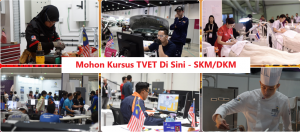PUTRAJAYA: The country ‘lost’ 147,422 students from national schools from 2006 to 2017.
The former deputy director general of Education Datuk Ahmad Tajudin Jab said that the figure constitutes some 30 per cent of students that enrolled in Standard 1 in 2006.
He was concerned about the direction in which the students took upon leaving school as there was a possibility that they would never return to school or pursue higher education.
At the same time, the ministry found low enrolment among Sijil Pelajaran Malaysia (SPM) leavers in Technical and Vocation Education Training (TVET).
The dejection felt upon failing to secure a place in public or private institutes of higher learning may be one of the reasons why some SPM leavers feel that furthering their studies after 11 years of schooling is an exercise in futility.
“How wonderful it would be if we could get those 30 per cent, or at least some of them to enrol in TVET.
“Their interest may not be in academics and TVET could offer a better alternative,” he said when presenting a working paper at a TVET roundtable discussion recently.
The discussion, organised by the National Professors Council (MPN), was chaired by its president cum CEO Prof Datuk Dr Raduan Che Rose and was attended by over 30 participants from institutes of higher education, government departments, parent-teachers associations, employer associations and youth organisations.
Among the major issues identified is the involvement of too many parties in the implementation of TVET in the country.
Identifying the issues
TVET issues have become so widespread that the Pakatan Harapan government had to establish a TVET Empowerment Committee in June and appoint Permatang Pauh MP Nurul Izzah Anwar as its chairperson.
In the Mid-Term Review of the 11th Malaysia Plan (RMK-11) which was tabled recently, Prime Minister Tun Dr Mahathir Mohamad had said that the government was working on improving the capabilities of youth in the field of TVET.
Among the issues plaguing TVET are the overlapping education system, the certification system, the lack of funding and the uncertain future of TVET graduates.
The ministries were the Rural and Regional Development Ministry (KKLW), the Education Ministry (KPM), the Higher Education Ministry (now under the Education Ministry), the Human Resources Ministry, the Youth and Sports Ministry, the Agriculture and Agro-based Industry Ministry, the Works Ministry and the Energy, Green Technology and Water Ministry (KeTTHA).
“Every ministry uses a different model and organises their own programmes. They have their own fields and they don’t share (those models) with the others. If we can promote the idea of a main institution, that would be progress,” said Raduan.
Other situations that also contribute to TVET issues are different curriculums for the same programme, the lack of a standardised certification system and bureaucracy issues when it comes to sharing human resources and equipment.
Standardise tvet
The discussion panel unanimously agreed that remedial measures need to be taken as soon as possible to address the plethora of problems plaguing TVET in this country.
They presented several proposals for the consideration of the government, including placing all TVET institutions under the purview of the Education Ministry.
They also recommended that the ministry be renamed the Ministry of Education and Training.
The national education system should also be revamped to reduce the number of students dropping out due to disinterest in academic learning, in addition to increasing the number of student enrolment in TVET among upper secondary school students at a rate of 30 per cent or a figure equivalent to other countries in the region.
They also recommended that Malaysia study TVET programme models under one ministry as successfully practised in countries like Finland, Germany, Austria, Australia, Singapore, South Korea and Japan.
In Finland, Germany, Austria, Singapore and South Korea have students entering TVET as young as 15 and 16 years old, eventually entering the workforce by age 18 and 19.
The panel also proposed that TVET institutions be consolidated into four institutions namely the Upper Secondary School Industry Apprenticeship (PIMA), the Upper Secondary Vocational Programme (PVMA), vocational college and polytechnic and a higher level TVET centre.
At the moment, there are 1,901 public and private TVET institutions in the nation.
Teaching manpower and accreditation
The discussion panel also proposed for the resolution of the difference in service schemes among TVET teachers.
They called for all TVET teachers who are still under class J (TVET teacher), DV (TVET teacher, DS (Malaysian Technical Universities) and others be switched into the DG scheme (Academic Teacher) or DH (Polytechnic and Community College) through special training at Teacher Education Training Institutes.
This would make it easier to relocate teachers to a certain state or district should there be a shortage of teaching manpower in the area.
It was also recommended that bodies involved in the accreditation of TVET institutions provide a specific approach to combining academic and practical training to eliminate the need for separate accreditation as is the practice today.
On the policy aspect, it was hoped that the government would review policies that could improve the marketability of TVET graduates by making it compulsory for workers in skill sectors to have a TVET certificate.
They also proposed for current workers to undergo competency tests so that they could become certified, as is the practice in Finland.
In addition to that, foreign workers should only be hired for non-supervisory or non-professional positions.
Raduan said it was time for the industry to join the government in the effort of empowering TVET sectors in the country, whether through financial support or strategic partnerships.
“TVET is skill-based and will eventually contribute to the industry.
The industry can play their role by sponsoring TVET students and absorbing them intro the workforce upon graduation,” he said.
Source: Bernama, 4th Nov 2018













